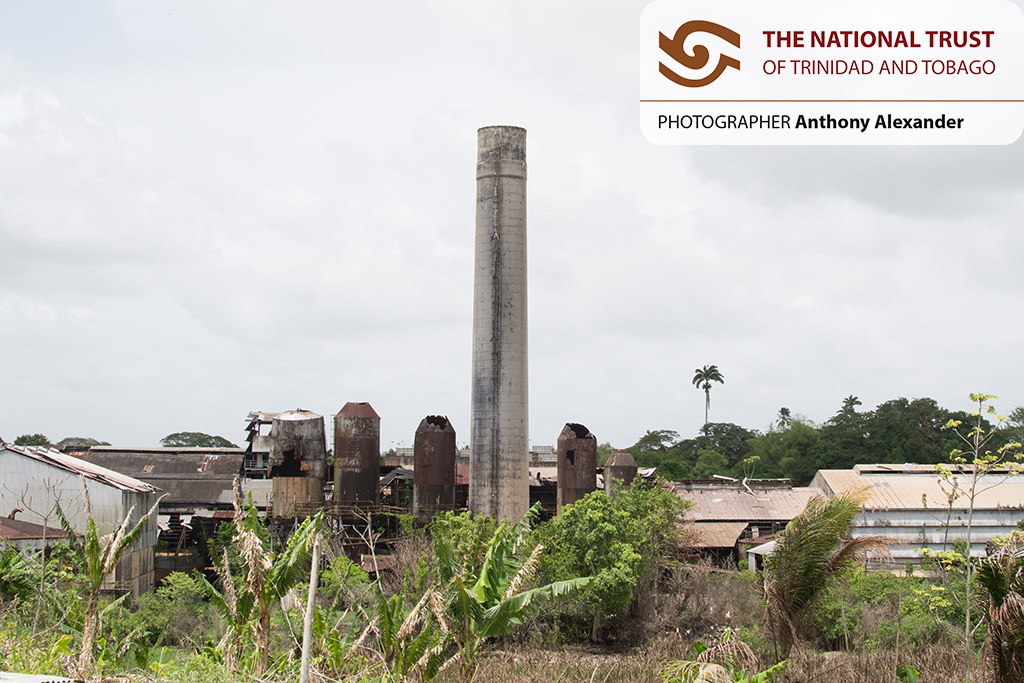Picture of Usine Ste. Madeleine Sugar Factory
Source: The Rise and Fall of King Sugar, National Archives of Trinidad and Tobago
The village of Ste. Madeleine is named after the estate Usine Ste. Madeleine. Ste. Madeleine estate was owned by Mary Madeleine in 1838. The estate benefitted from the Cipero River which passed through the estate, giving it a considerable advantage over other estates. The River was the main way to transport sugar from the estates to the sea. By 1850 the Ste. Madeleine estate was doing well. The estate was later taken over by the Colonial Company which led the way in the joining of estates and modernization of the sugar production process at Ste. Madeleine. Around 1870-1872 the Usine or factory was built on the estate by George Fletcher & Co. of Derby, England, for the Colonial Company. The Company at the point in time was investing in upgrading machinery and transport facilities in British Guiana and Trinidad. It spent £213,000 on the construction of the Usine at Ste. Madeleine (Besson, 2018). In 1859 the Cipero Tramway was established. This was an agricultural line connecting the Cipero Wharf in San Fernando to Usine Ste. Madeleine. It initially used mules for transportation but in 1861 the line was extended east to Princes Town and in 1864 the first steam locomotive was introduced (Kautzor, 2014). A railway was set up to transport cane from the estates to the Usine.
This new Usine came with new changes to the processing of sugar. The Company introduced Vacuum Pan Process which at the point in time was only used by the Brechin Castle Estate (Anthony, 1988). The highest grade was the golden sugar, which sold for 9 cents per pound (Anthony, 1988). This was also the first central sugar factory in Trinidad and Tobago, which meant that cane from surrounding estates were sent there for processing. It was the largest sugar factory at the point in time in the British Empire.
In the 1950s Tayte and Lyle purchased Usine Ste. Madeleine, making it the colony’s and later nation’s largest producer of sugar, molasses, rum and bagasse.
Sources:
Anthony, Michael.1988. Towns and Villages of Trinidad and Tobago. Port of Spain: Circle Press.
Besson, Gerard. 2018. Sweet Sorrow: The Timeline of Sugar in Trinidad and Tobago,
16th–18th Century. The Caribbean History Archives. http://caribbeanhistoryarchives.blogspot.com/2018/12/sweet-sorrow-timeline-of-sugar-in.html
Kautzor, Thomas. 2014. The Railways of Trinidad. https://www.internationalsteam.co.uk/trains/trinidad01.htm
National Archives of Trinidad and Tobago. The Rise and fall of King Sugar. http://www.natt.gov.tt/sites/default/files/pdfs/The-Rise-and-Fall-of-King-Sugar.pdf
Outdoors Trinidad. Ste. Madeleine Train History. https://www.trinoutdoors.com/pages/other%20places.htm#Ste_Madeline_Train_History
University of the West Indies. The Usine, St. Madeleine, A Central Sugar Factory in Trinidad. Michael Goldberg Postcard Collection. http://hdl.handle.net/2139/5181
Other Known Name: Usine Ste Madeleine
Address: M1 Ring Road
Town/City: Ste Madeleine
Region: Princes Town
Site Type: Cultural Heritage
Ownership:
Public Accessibility:
Cultural Community: British
Site Features: Sugar Estates
M1 Ring Road, Ste Madeleine, Princes Town



